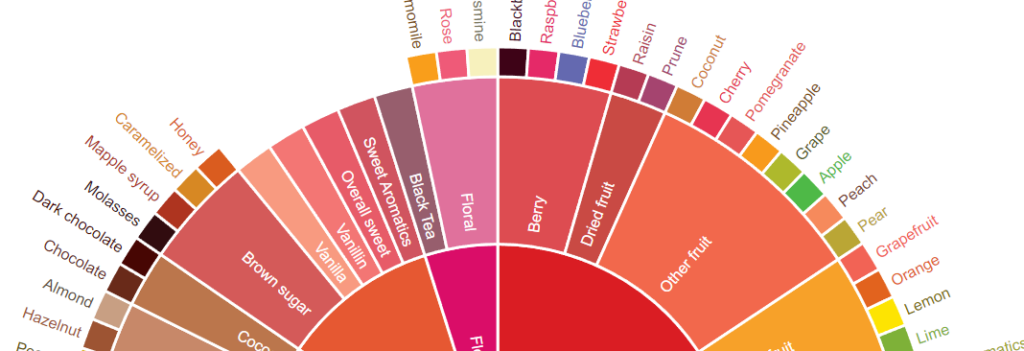
The coffee flavor wheel is a visual representation of the various taste profiles that coffee can exhibit. It helps to organize and understand the complex nuances of coffee flavors. While there are many variations of the coffee flavor wheel, they generally include a central core of neutral flavors and then radiate outwards to more specific taste profiles.
This page is a clean example of the full wheel. This version is interactive providing a greater level of detail
The Core of the Coffee Flavor Wheel
At the center of the coffee flavor wheel lies a neutral core, often represented by terms like “balanced,” “clean,” and “sweet.” These coffees are considered well-rounded, without any overpowering or unpleasant flavors. They are a good starting point for those new to coffee tasting, as they offer a baseline for comparison.
Radiating Outwards: The Flavor Profiles
As you move outwards from the center, the flavor profiles become more specific and pronounced. Here are some common categories found on the coffee flavor wheel:
Parts of the wheel
- Acidity: This refers to the bright, tart, or citrusy flavors in coffee. It can be a pleasant quality, adding a refreshing zing. Examples of acidic flavors include lemon, grapefruit, or apple.
- Bitterness: This is the opposite of acidity, characterized by a harsh, astringent taste. While often associated with low-quality coffee, bitterness can be a desirable quality in certain types of coffee, adding complexity and depth.
- Body: This refers to the perceived weight or thickness of the coffee. A full-bodied coffee feels heavy on the tongue, while a light-bodied coffee is more delicate.
- Sweetness: This is the presence of natural sugars in the coffee, which can contribute to a pleasant, balanced flavor.
- Flavor Notes: This category encompasses a wide range of specific flavors that can be detected in coffee, such as chocolate, caramel, nuts, spices, or fruit. These flavors can be influenced by factors like the coffee bean variety, roasting method, and brewing technique.
Factors Affecting Coffee Flavor
Several factors can influence the flavor profile of a coffee, including: Coffee Bean Variety: Different coffee bean varieties have unique flavor characteristics. For example, Arabica beans are generally considered to have a more complex and refined flavor profile than Robusta beans. Also where a bean is grown has a huge impact on the flavor profile of the bean.
Roasting Level: The roasting process significantly impacts the flavor of coffee. Light roasts tend to be more acidic and fruity, while dark roasts are often more bitter and smoky.
Brewing Method: The method used to brew coffee can also affect its flavor. For example, espresso extraction is known for producing a bold, concentrated flavor, while pour-over brewing can result in a more delicate, nuanced cup.
By understanding the coffee flavor wheel and the factors that influence coffee flavor, you can develop a deeper appreciation for this complex and delicious beverage. Whether you’re a seasoned coffee connoisseur or just starting your journey, the flavor wheel can be a valuable tool for exploring the vast world of coffee.
